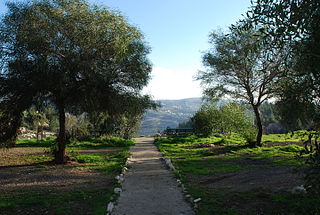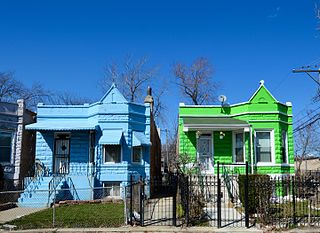
Hull House was a settlement house in the United States that was co-founded in 1889 by Jane Addams and Ellen Gates Starr. Located on the Near West Side of Chicago, Illinois, Hull House opened to recently arrived European immigrants. By 1911, Hull House had grown to 13 buildings. In 1912 the Hull House complex was completed with the addition of a summer camp, the Bowen Country Club. With its innovative social, educational, and artistic programs, Hull House became the standard bearer for the movement that had grown, by 1920, to almost 500 settlement houses nationally.

Humboldt Park, one of 77 designated community areas, is on the West Side of Chicago, Illinois. The Humboldt Park neighborhood is known for its dynamic social and ethnic demographic change over the years. The Puerto Rican community has identified strongly with the area since the 1970s; Humboldt Park is also the name of a 207-acre (0.8 km²) park adjacent to the community area.

North Lawndale, known to residents as simply "Lawndale", is located on the West Side of Chicago, Illinois. It is one of the well-defined community areas in the city of Chicago.

Lower West Side is a community area on the West Side of Chicago, Illinois, United States. It is three miles southwest of the Chicago Loop and its main neighborhood is Pilsen. The Heart of Chicago is a neighborhood in the southwest corner of the Lower West Side.
The Jewish United Fund of Metropolitan Chicago (JUF) is the central philanthropic address of Chicago's Jewish community and one of the largest not-for-profit social welfare institutions in Illinois. JUF provides critical resources that bring food, refuge, health care, education and emergency assistance to 300,000 Chicagoans of all faiths and 2 million Jews in Israel and around the world, funding a network of nearly 70 agencies and programs.

Congregation Beth Israel is a synagogue located in West Hartford, Connecticut. The synagogue is one of the two oldest Jewish congregations in Connecticut and one of the largest Reform Jewish congregations in New England, with about 900 member families and about 2,000 individual members.

Kiryat Menachem is a neighborhood in southwest Jerusalem. It is bordered by Ir Ganim to the south and east, Mount Ora to the west, and the Jerusalem hills to the north. To the west are steep hills that descend toward streams that flow into Nahal Sorek to the north of Hadassah Ein Karem Hospital. The neighborhood overlooks the village of Ein Karem, Nahal Sorek, and the ruins of Sataf.

Lawndale is a neighborhood in Northeast Philadelphia. It is located near Rising Sun and Oxford avenues and is south of Cottman Avenue.

The West Vernor–Lawndale Historic District is a two-block commercial historic district located along West Vernor Highway between Cabot and Ferris Streets in Detroit, Michigan. The district includes 30 acres (120,000 m2) and 10 buildings. It was listed on the National Register of Historic Places in 2002.

Young Men's and Young Women's Hebrew Association Building, also known as the Jewish Community Center, is a historic building located in central Baltimore, Maryland, United States. It is a three-story, flat-roofed, rectangular-shaped Flemish bond brick structure completed in 1930. The exterior features Moorish and Jewish motifs, such as the Star of David. It was designed by Baltimore architect Joseph Evans Sperry. It is now an apartment building. The establishment of the joining YM/YWHA building was a notable example of an attempt to bridge the divide between uptown Baltimore's prosperous German Jews and East Baltimore's impoverished Eastern European and Russian Jews. The association building was constructed midway between uptown and East Baltimore to symbolize this coming together of the two halves of Baltimore's Jewish community.

Jewish Council on Urban Affairs (JCUA) is a not-for-profit organization based in Chicago, Ill., that works with diverse neighborhoods and community groups to battle discrimination, antisemitism, poverty and other forms of oppression. Judy Levey is the current executive director.
Gads Hill Center is a non-profit youth education and family resource center on Chicago's South Side, United States, established in 1898. With its headquarters in Chicago, Gads Hill Center serves families in the Chicago neighborhoods of Lower West Side (Pilsen), North Lawndale and South Lawndale with programming that provides learning support and educational enrichment, early childhood development, and out-of-school care for children.

The Pilsen Historic District is a historic district located in the Pilsen neighborhood of Chicago. Pilsen is a neighborhood made up of the residential sections of the Lower West Side community area of Chicago. In the late 19th century Pilsen was inhabited by Czech immigrants who named the district after Plzeň, the fourth largest city in what is now the Czech Republic. The population also included in smaller numbers other ethnic groups from the Austro-Hungarian Empire including Slovaks, Slovenes, Croats and Austrians, as well as immigrants of Polish and Lithuanian heritage.

The Shedd Park Fieldhouse is the historic fieldhouse in Shedd Park, a public park in the South Lawndale community area of Chicago, Illinois. John G. Shedd, for whom the park and fieldhouse are named, gave the city the land for the park. The Prairie School building was designed by William Drummond and built in 1917. The brown brick building features limestone trim. A Prairie School gymnasium designed by Michaelsen and Rognstad was added to the building in 1928.

Unity Hall is a historic building located at 3140 S. Indiana Ave. in the Douglas community area of Chicago, Illinois. Built in 1887, the building originally served as a Jewish social club called the Lakeside Club. The red brick building, designed by local architect L.B. Dixon, features terra cotta decorations and sheet metal edging. In 1917, Chicago alderman Oscar Stanton De Priest founded the Peoples Movement Club and made Unity Hall its headquarters. De Priest was the first African-American to serve on the Chicago City Council, and he established the Peoples Movement Club to organize the black community politically. The Peoples Movement Club became "one of the best organized political groups" in Chicago's Black Metropolis neighborhood, and De Priest became the first African-American U.S. Representative from the northern states in 1928.
At the end of the 20th century there were a total of 270,000 Jews in the Chicago area, with 30% in the city limits. In 1995 there were 154,000 Jews in the suburbs of Chicago. Of them, over 80% of the Jews in the suburbs of Chicago live in the northern and northwestern suburbs. In 1995, the largest Jewish community in the City of Chicago was in West Rogers Park. By 1995 the Jewish population within the City of Chicago had been declining, and it tended to be older and more well educated than the Chicago average. Jews in Chicago came from many national origins including those in Europe and Middle East, with Eastern Europe and Germany being the most common.

The West Side is one of the three major sections of the city of Chicago in Cook County, Illinois, along with the North Side and the South Side. The West Side consists of communities that are of historical, cultural, and ideological importance to the history and development of Chicago. On the flag of Chicago, the West Side is represented by the central white stripe.

Society Hill Synagogue is a synagogue located in the Society Hill section of Center City Philadelphia. The synagogue is home to a 300-household congregation with Shabbat and holiday services, a Hebrew school, a Playschool, adult education, social programs and arts and culture initiatives, social action opportunities, and community programming.

The K-Town Historic District is a historic district listed on the National Register of Historic Places located in the North Lawndale community area in Chicago, Illinois. A mainly residential area, its borders are West Cullerton Street to the north, South Pulaski Road to the east, West Cermak Road to the south, and South Kostner Avenue to the west.

Central Park Theater is a historic theater building at 3531-39 W. Roosevelt Road in the Lawndale neighborhood of Chicago, Illinois. Built in 1917, the theater was the first in the Balaban and Katz chain. Chicago architectural firm Rapp and Rapp designed the Spanish Revival building; their design led them to become the main architects for Balaban and Katz, and later for Paramount Pictures. The firm's design featured two prominent towers on its front facade and was decorated with red brick and terra cotta. The theater was also the first in the world to include mechanical air conditioning, which featured prominently in its advertising during the summer. It provided entertainment to both Lawndale's Jewish community and the African-American community that replaced it in the 1950s, and it is one of the few remaining Lawndale business from the early twentieth century. The theatre was the inspiration for the well known Call of Duty Zombies map, Kino Der Toten.




















